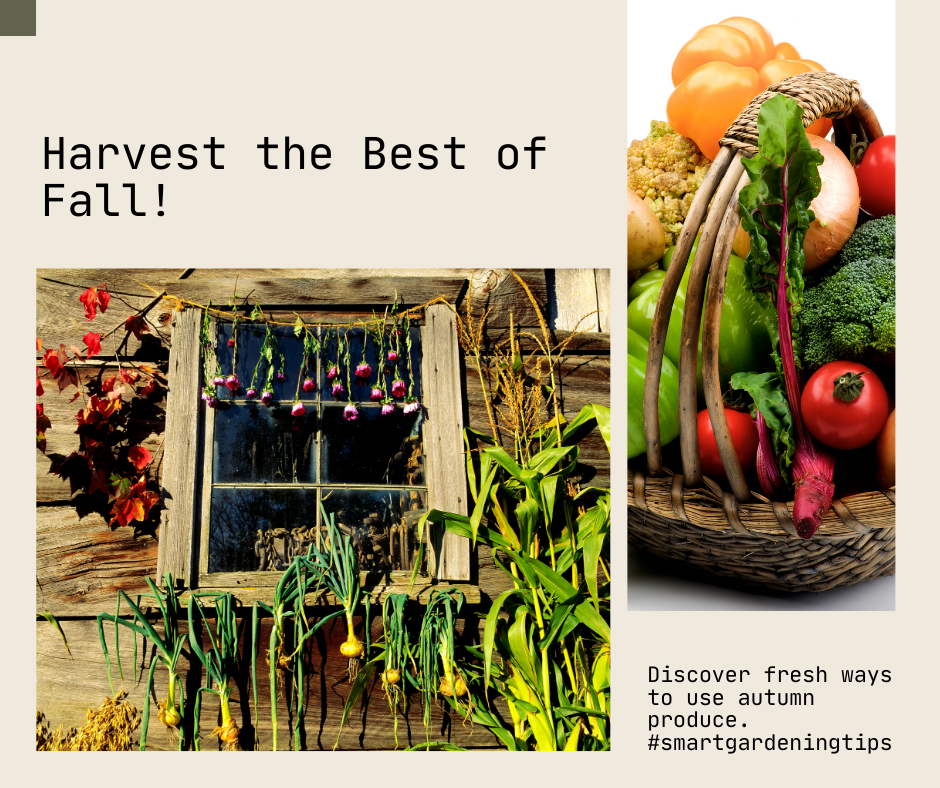
In this section, we will provide you with a variety of autumn crop options for your garden. Discover the best crops to harvest in autumn and get suggestions for maximizing your yield.
Key Takeaways:
- Explore a range of crops that thrive in the autumn season.
- Learn how to maximize your yield with expert tips.
- Discover nutrient-rich vegetables and delicious fruits for your autumn harvest.
- Find out how to preserve your harvest for future use.
- Enjoy the health benefits and flavors of homegrown produce.
Best Autumn Crops to Harvest
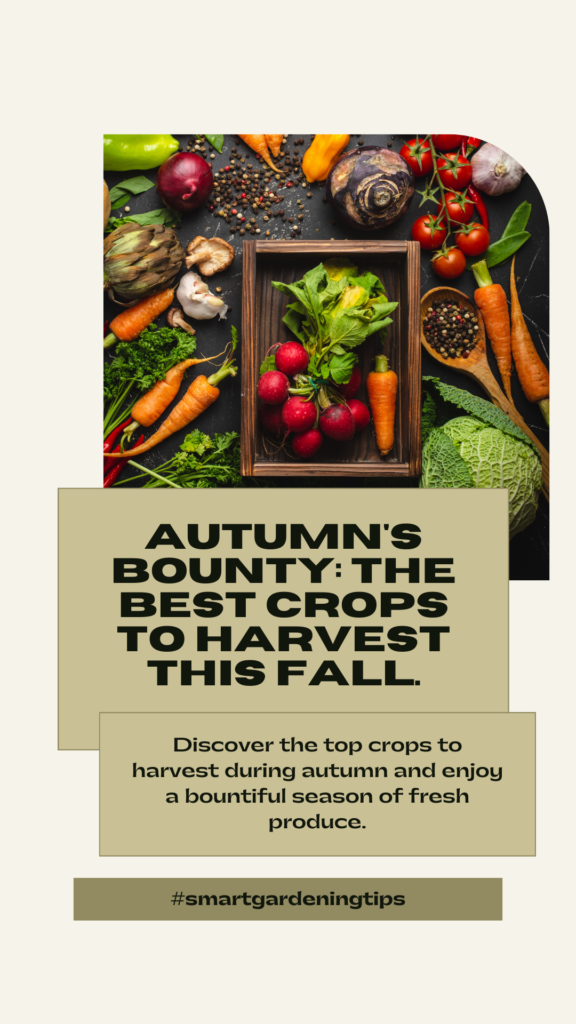
As the summer warmth begins to fade, it’s time to shift our focus to the best crops to harvest in autumn. This season presents a wonderful opportunity for home gardeners to enjoy the delicious flavors of freshly grown vegetables and fruits. Cooler temperatures create the ideal conditions for these crops to thrive, ensuring a bountiful harvest and a satisfying culinary experience. So, let’s explore the top autumn crops that you can grow in your own garden.
1. Leafy Greens
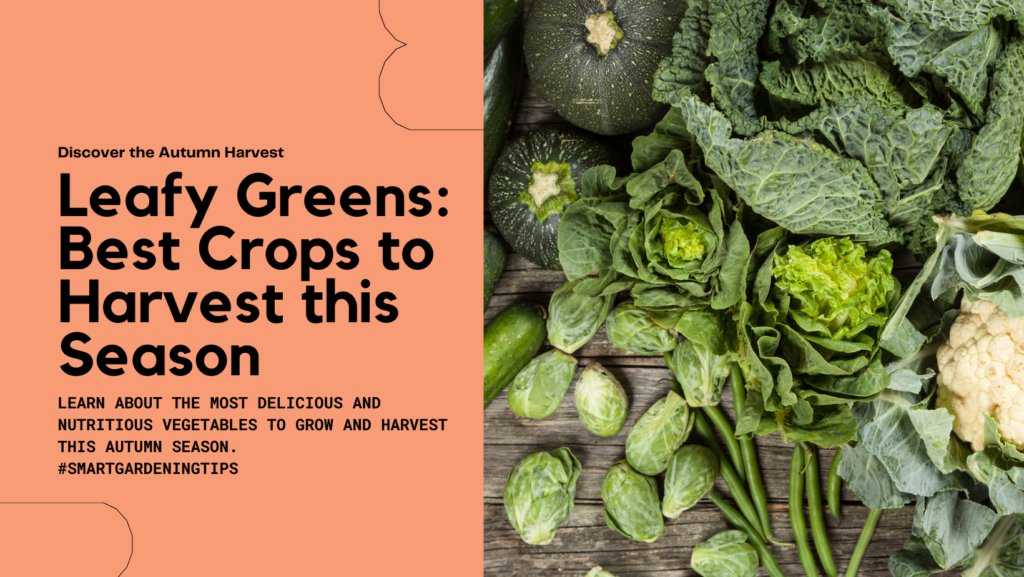
Autumn is the perfect time to cultivate a variety of leafy greens such as spinach, kale, and lettuce. These crops appreciate the cooler weather and often produce more vibrant and tender leaves during this season. Rich in essential nutrients, leafy greens are a fantastic addition to your autumn harvest.
2. Root Vegetables
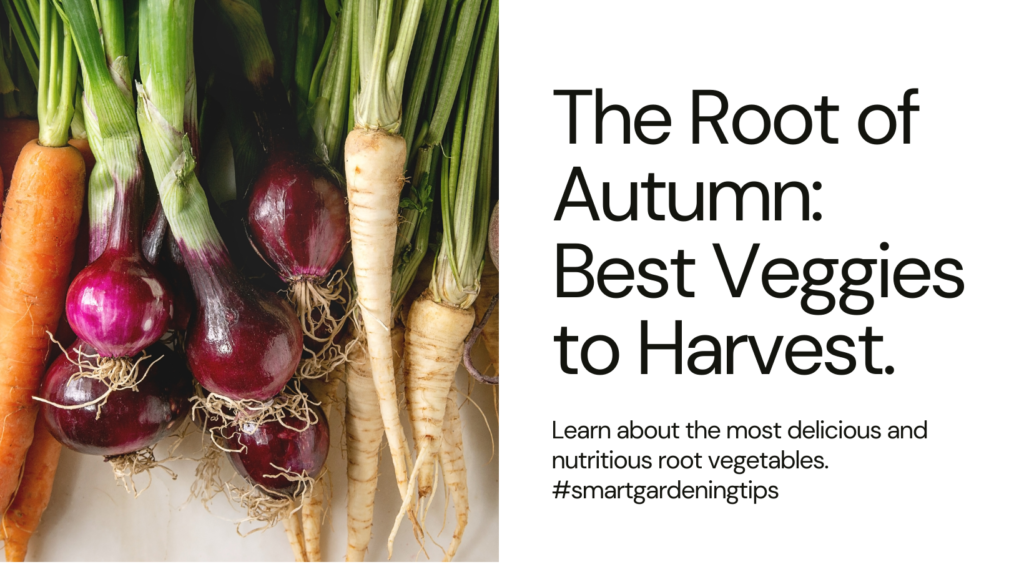
Root vegetables like carrots, beets, and radishes are well-suited for autumn gardening. The cool soil temperatures enhance their flavor and texture, resulting in sweeter and crisper roots. These versatile vegetables can be used in a wide range of dishes, from comforting soups to hearty roasted vegetable medleys.
3. Brassicas
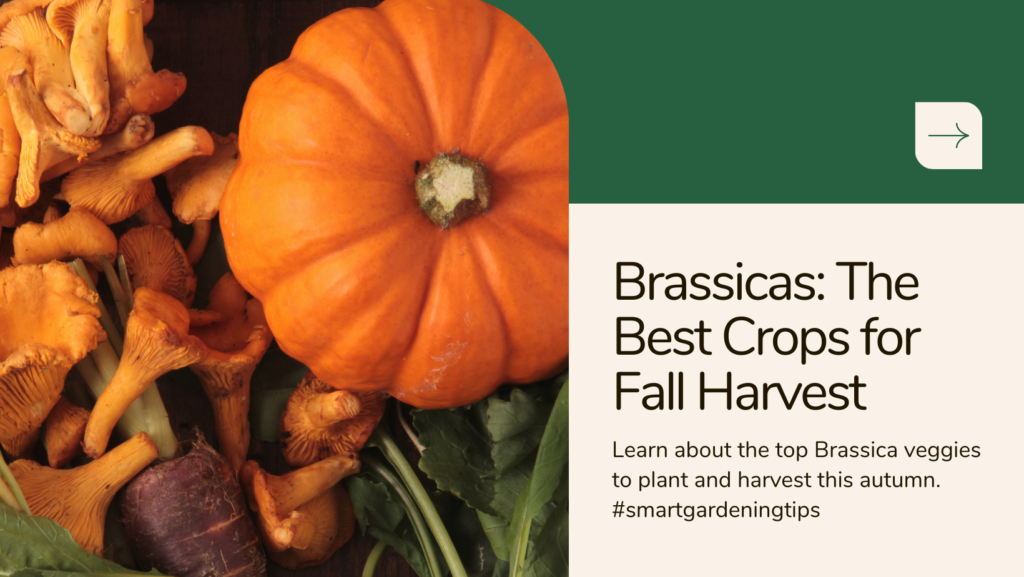
Brassicas, including broccoli, cauliflower, and Brussels sprouts, thrive in cooler temperatures, making them excellent choices for autumn harvest. These nutrient-dense vegetables offer a wealth of culinary possibilities, whether steamed, roasted, or added to stir-fries. With their distinct flavors and vibrant colors, brassicas bring a delightful touch to your fall meals.
| Crop | Best Growing Conditions | Harvest Time |
|---|---|---|
| Spinach | Partial shade, well-drained soil | 45-55 days |
| Carrots | Loose, sandy soil | 60-80 days |
| Cauliflower | Full sun, fertile soil | 60-80 days |
4. Apples and Pears
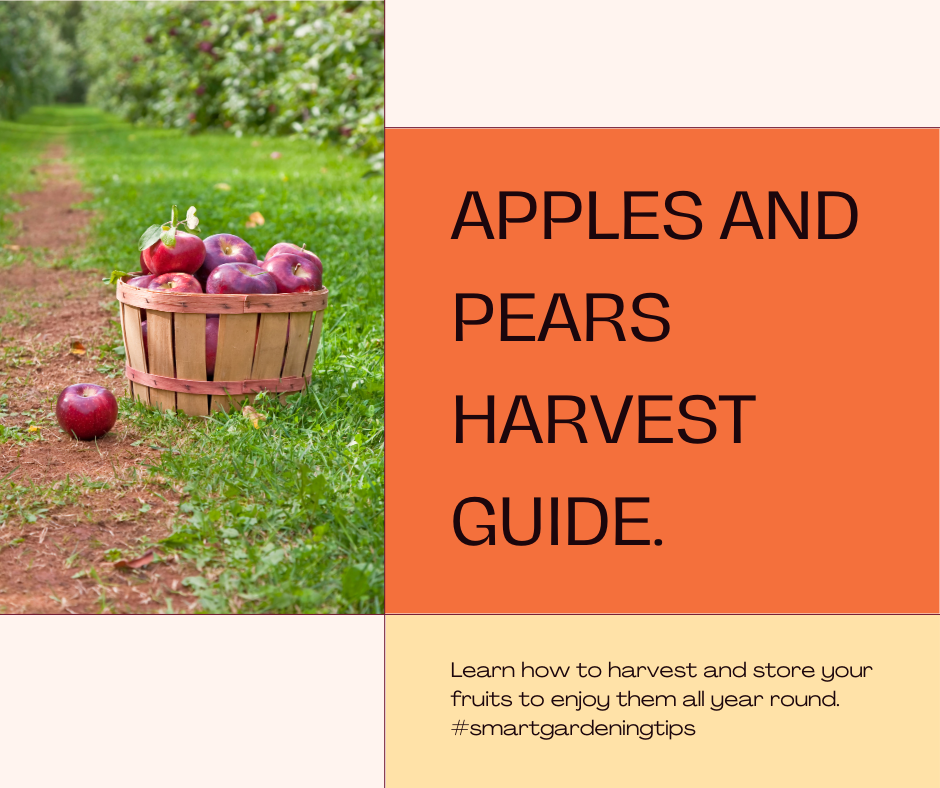
No autumn harvest would be complete without the inclusion of delicious apples and pears. These fruits thrive in cooler weather and offer a wide range of flavors and textures. Whether eaten fresh, used in baking, or transformed into homemade preserves, apples and pears add a delightful sweetness to your autumn menu.
5. Berries
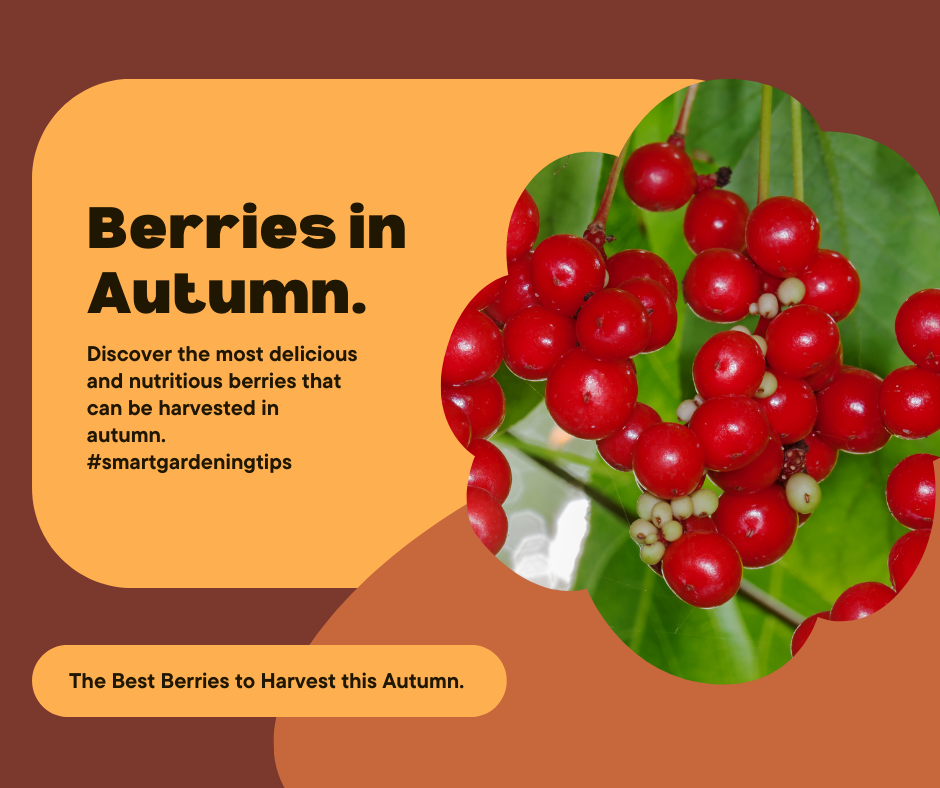
While many think of berries as a summer treat, certain varieties such as raspberries, blackberries, and cranberries can be harvested well into the autumn months. These colorful and tangy fruits are not only packed with antioxidants but also lend themselves well to desserts, jams, and smoothies.
With the right selection of crops, your autumn garden can be a source of fresh and flavorful produce throughout the season. By incorporating these best crops to harvest in autumn, you can enjoy the rewards of your hard work and create delicious meals with homegrown ingredients.
Tips for Growing Crops Successfully in the Fall Season
When it comes to growing crops in the fall, there are some essential tips and tricks to keep in mind. With the right preparations and care, you can ensure a successful autumn harvest. Follow these expert tips to maximize your yield and enjoy a bountiful harvest of fresh, homegrown produce.
Prepare Your Soil
Before planting your fall crops, take the time to prepare your soil properly. Clear away any debris or weeds and amend the soil with organic matter, such as compost or well-rotted manure. This will improve soil fertility, drainage, and moisture retention, creating optimal conditions for your crops to thrive.
Choose the Right Varieties
Selecting the right crop varieties is crucial for successful autumn gardening. Look for crops that are well-suited to cooler temperatures and have shorter maturation times. Some popular choices for fall crops include kale, spinach, lettuce, radishes, and carrots. Opting for cold-hardy varieties will increase your chances of a successful harvest.
Manage Watering Carefully
Proper watering is essential for the growth and development of your fall crops. With cooler temperatures and increased rainfall, you may need to adjust your watering schedule accordingly. Monitor the moisture levels in the soil and water your crops when necessary, ensuring that they receive adequate hydration without becoming waterlogged.
Implement Pest Control Measures
Just like in any other season, pests can pose a threat to your fall crops. Be proactive in implementing pest control measures to protect your plants. Regularly inspect your crops for signs of pests or diseases, and take appropriate action, such as using organic pesticides or physical barriers, to prevent infestations.
Extend the Growing Season
If you want to extend your growing season even further into the fall, consider using protective covers, such as row covers or tunnels. These can help create a microclimate around your plants, providing added warmth and protection from frost. By extending your growing season, you can continue harvesting fresh crops well into the autumn months.
Harvest at the Right Time
Knowing when to harvest your fall crops is crucial for their flavor and quality. Pay attention to the recommended harvest times for each crop and monitor their progress regularly. Harvest leafy greens when they are young and tender, and root crops when they have reached their desired size. Harvesting at the right time will ensure optimal taste and texture.
By following these tips for growing crops successfully in the fall season, you can ensure a productive and rewarding autumn harvest. With proper soil preparation, careful watering, pest control measures, and the right timing for harvesting, you’ll be able to enjoy a plentiful supply of fresh, homegrown vegetables throughout the fall.
Nutritious Fall Vegetables to Grow
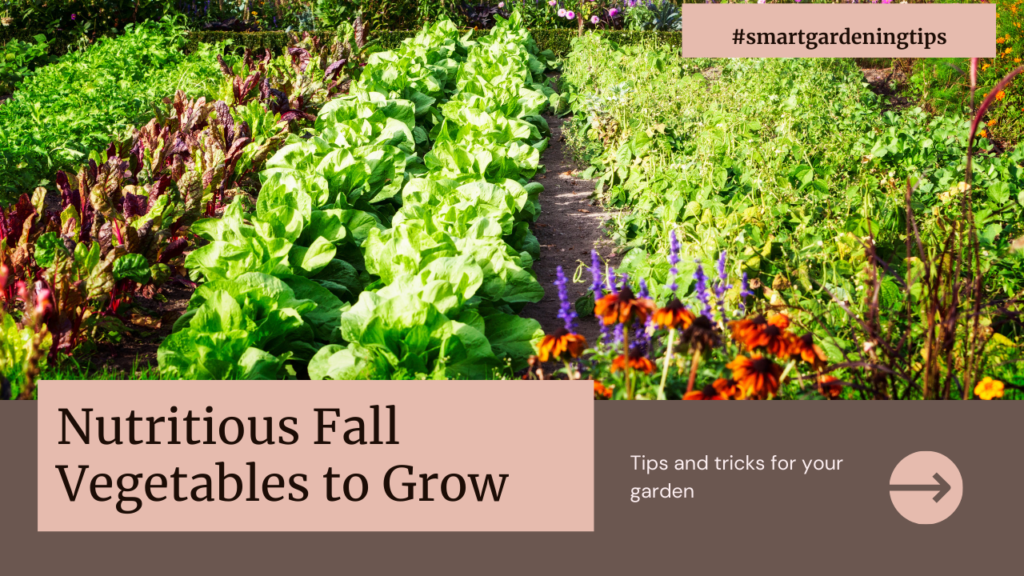
When it comes to fall gardening, there are several nutrient-rich vegetables that thrive in cooler temperatures and offer a bountiful autumn harvest. Incorporating these vegetables into your meals not only adds flavor and variety but also provides essential vitamins and minerals for a healthy diet.
Top Nutrient-Rich Vegetables for Autumn Harvest
Below is a selection of highly nutritious fall vegetables that you can grow and enjoy:
| Vegetable | Nutritional Benefits |
|---|---|
| Pumpkin | Rich in beta-carotene, fiber, and antioxidants |
| Brussels Sprouts | Excellent source of vitamin C, vitamin K, and folate |
| Beets | Packed with vitamins A, C, and K, as well as fiber and iron |
| Kale | High in vitamins A, C, and K, and a great source of antioxidants |
| Butternut Squash | Loaded with vitamins A and C, magnesium, and potassium |
These fall vegetables offer a wide range of health benefits, including immune support, improved digestion, and reduced inflammation. By growing them in your garden, you ensure they are fresh, flavorful, and packed with nutrients.
Remember, when selecting seeds or seedlings for these vegetables, choose varieties that are suited to your climate and growing conditions to ensure optimal harvest.
Achieving a bountiful autumn harvest of nutritious vegetables is not only beneficial for your health but also a rewarding experience. Whether you enjoy them roasted, steamed, or incorporated into soups and stews, these vegetables will add seasonal flair and a burst of flavor to your fall meals.
Autumn Fruits for a Bountiful Harvest
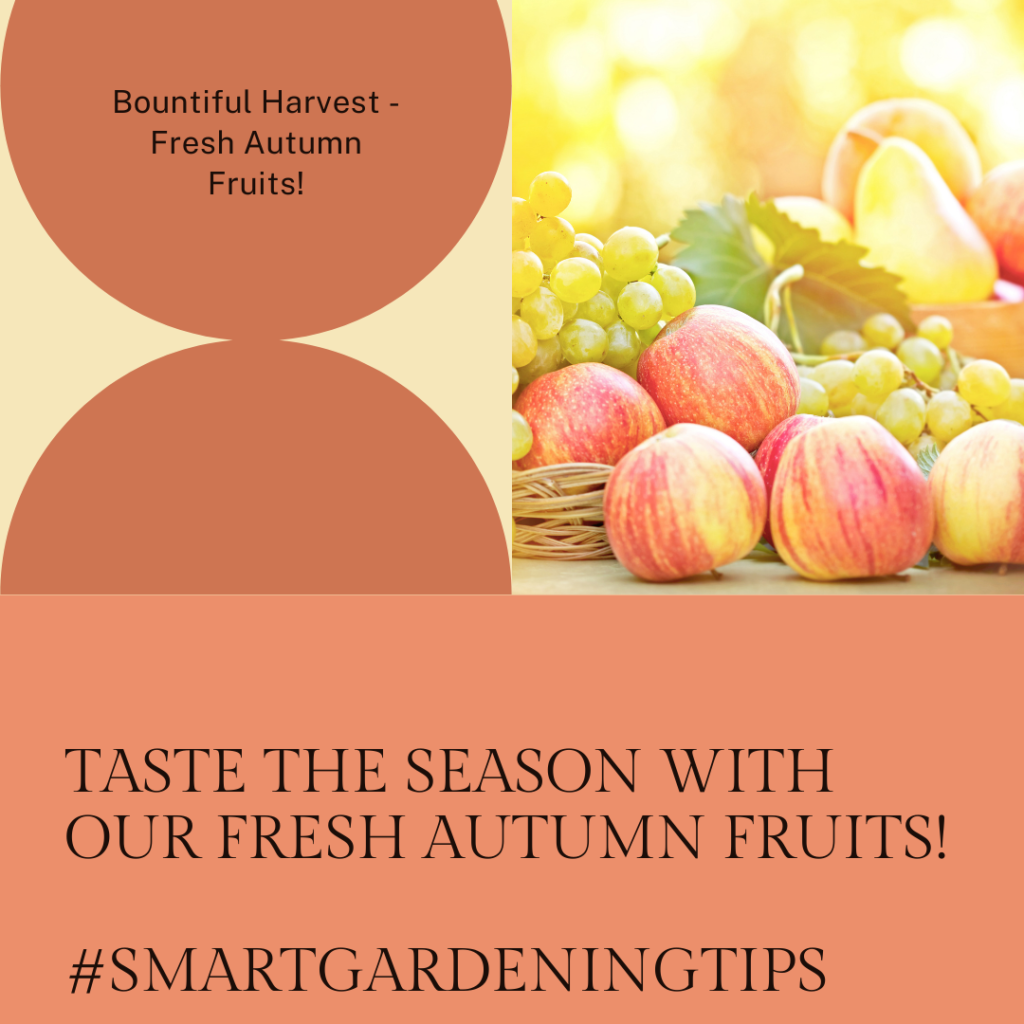
Autumn is a wonderful time to enjoy a rich harvest of delicious fruits. From apples and pears to berries and grapes, there are plenty of fruit varieties that thrive in the cooler temperatures of autumn, ensuring a bountiful harvest for your garden.
One of the advantages of growing fruits in autumn is that the cooler temperatures help enhance their flavor and sweetness. Plus, many fruits are at their peak ripeness during this time, ensuring a taste sensation with every bite.
Here are some recommended autumn fruits to grow and harvest:
- Apples: A fall favorite, apples come in a myriad of varieties, each with its own unique flavor and texture. From sweet Honeycrisp to tart Granny Smith, apples offer endless possibilities for baking, juicing, or enjoying fresh.
- Pears: Juicy and aromatic, pears are another popular choice for autumn harvest. Choose from crisp varieties like Bartlett or the meltingly tender Comice. Pears can be enjoyed on their own or used in a variety of sweet and savory dishes.
- Berries: While berries are typically associated with summer, some varieties thrive in the fall as well. Look for late-season raspberries, blackberries, and blueberries that offer a burst of sweetness in every berry.
- Grapes: Autumn is synonymous with grape harvest, with vineyards abuzz with activity. Whether you grow table grapes or those for winemaking, they are a delightful addition to seasonal fruit salads or enjoyed as a refreshing snack.
To ensure a successful harvest, proper care and maintenance are essential. Ensure your fruit trees and bushes receive adequate sunlight, water, and nutrients. Pruning and protecting against pests and diseases will help them thrive.
So, whether you have a spacious backyard or a cozy balcony, consider growing these autumn fruits to enjoy a bountiful and flavorful harvest.
Herbs and Spices for Fall Harvest
When it comes to cultivating a vibrant autumn garden, don’t forget about the aromatic and flavorful herbs and spices that can be harvested during this season. Fall is the perfect time to plant and nurture a variety of herbs and spices that will enhance your culinary creations and add a touch of warmth to your dishes. Whether you’re an experienced gardener or a beginner, growing these popular herbs and spices in autumn will not only provide you with an abundant harvest but also elevate your cooking to new heights.
So, which herbs and spices are ideal for the fall? Here are some popular options:
- Rosemary: This fragrant and versatile herb is a staple for many autumn dishes. Its woody aroma and distinct pine-like flavor complement roasted meats, root vegetables, and hearty sauces.
- Sage: With its earthy and savory taste, sage is a must-have herb for fall cooking. It pairs well with poultry, stuffings, and squash dishes, adding depth and complexity to your recipes.
- Thyme: Known for its delicate yet robust flavor, thyme is a fantastic addition to fall soups, stews, and roasted vegetables. Its aromatic essence will infuse your dishes with warmth and richness.
- Cinnamon: This sweet and warming spice is synonymous with autumn flavors. Sprinkle it on baked goods, hot beverages, and even roasted vegetables for a comforting and cozy touch.
- Nutmeg: Another quintessential fall spice, nutmeg adds warmth and depth to both sweet and savory dishes. Use it in pumpkin recipes, creamy sauces, and even sprinkle it on roasted butternut squash for a delightful twist.
“Autumn is the time to savor the rich flavors and aromas of herbs and spices. From the earthiness of sage to the warmth of cinnamon, fall harvest brings a bounty of exciting culinary possibilities.”
Now that you know which herbs and spices to cultivate in autumn, it’s time to explore different ways you can use them in your cooking to create delicious meals that capture the essence of the season. Let your garden be your treasure trove of flavors and embark on a culinary adventure filled with the vibrant taste of fall.
Creative Ways to Use Herbs and Spices from Your Harvest
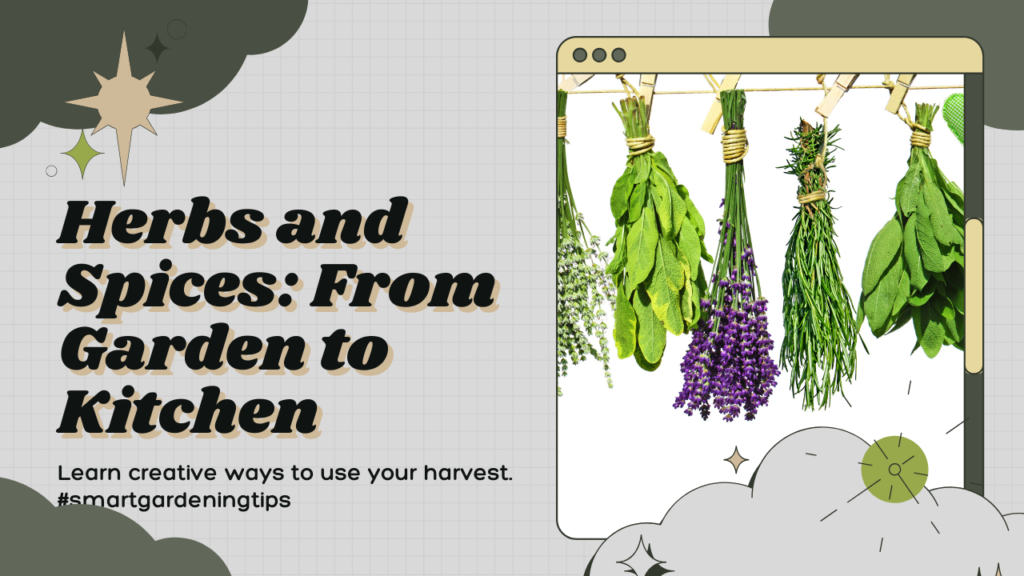
Now that you’ve harvested a glorious collection of herbs and spices from your garden, it’s time to get creative in the kitchen. Elevate your dishes with the aromatic flavors of autumn using these inventive recipes that showcase the best of your homegrown ingredients. From vibrant herb-infused dishes to tantalizing spice blends, you’ll discover new and exciting ways to savor the fruits of your labor.
1. Herbs for Zesty Salads
Take your salads to the next level by incorporating a variety of freshly harvested herbs. From peppermint to cilantro, these flavorful additions bring a burst of freshness and complexity to your greens. Experiment with different combinations and create your own signature herb-infused salad dressing. Here’s a simple recipe to get you started:
Mint and Basil Vinaigrette:
- 1 cup fresh mint leaves
- 1 cup fresh basil leaves
- 2 cloves of garlic
- ½ cup extra virgin olive oil
- 2 tablespoons lemon juice
- 1 tablespoon honey
- Salt and pepper to taste
In a blender, combine the mint, basil, garlic, olive oil, lemon juice, honey, salt, and pepper. Blend until smooth. Drizzle over your favorite salad and enjoy!
2. Spice Blends for Flavorful Entrees
Enhance the taste of your autumn dishes with homemade spice blends. Mix and match different spices to create rich, aromatic combinations that add depth and complexity to your meals. Whether you’re grilling meat, sautéing vegetables, or making soups and stews, these custom spice blends will take your recipes to the next level. Here’s a versatile blend to try:
Autumn Spice Blend:
- 2 tablespoons ground cinnamon
- 1 tablespoon ground ginger
- 1 tablespoon ground nutmeg
- 1 tablespoon ground cloves
- 1 tablespoon ground allspice
- 1 teaspoon ground cardamom
Mix all the spices together and store in an airtight container. Sprinkle this blend on roasted vegetables, add it to baking recipes, or use it as a seasoning for meats and poultry.
3. Herb-Infused Oils and Butters
Infusing oils and butters with your homegrown herbs is a great way to preserve their flavors and create a versatile ingredient for your cooking. Use herb-infused oils to drizzle over pasta, pizza, or roasted vegetables, or spread herb-infused butter on warm bread or scones. The possibilities are endless! Here’s a simple recipe to make your own herb-infused oil:
Rosemary Infused Olive Oil:
- 1 cup extra virgin olive oil
- A handful of fresh rosemary sprigs
In a small saucepan, heat the olive oil and rosemary sprigs over low heat for about 5 minutes. Remove from heat and let it cool completely. Strain the oil into a glass container and discard the rosemary sprigs. Use this fragrant oil to add a hint of rosemary to your dishes.
These creative ways to use herbs and spices from your harvest will transform your culinary adventures into a flavorful journey. From vibrant salads to delicious entrees, let your imagination run wild as you experiment with different combinations and techniques. Enjoy the beautiful flavors of autumn, straight from your garden to your plate.
| Herb or Spice | Flavor Profile | Best Pairings |
|---|---|---|
| Rosemary | Earnthy and piney | Roasted potatoes, grilled lamb |
| Basil | Herbaceous and slightly sweet | Tomatoes, mozzarella, pasta |
| Thyme | Earthy and lemony | Roasted chicken, roasted vegetables |
| Cumin | Warm and earthy | Curries, chili, roasted vegetables |
| Cinnamon | Sweet and warm | Baked goods, oatmeal, spiced drinks |
Preserving Your Autumn Harvest
As the autumn season arrives and your garden is filled with an abundant harvest, it’s essential to know how to preserve your fresh produce. By employing various methods for storing and preserving your crops, you can enjoy the flavors of autumn all year round. From canning and freezing to drying and pickling, we’ll guide you through the techniques that will help you make the most of your autumn harvest.
1. Canning
Canning is a popular and effective method for preserving your autumn crops. By using the process of heat sterilization, you can seal your fruits, vegetables, and even jams and jellies in airtight jars, ensuring their longevity. Whether you’re canning pickles, tomatoes, or applesauce, the process involves preparing your produce, filling sterilized jars, and sealing them with lids and bands. The heat treatment then kills any bacteria or yeast, preventing spoilage and allowing you to savor your autumn harvest throughout the year.
2. Freezing
Freezing is a convenient and simple way to preserve your fresh produce, preserving their flavor and nutrients. By blanching your vegetables before freezing, you can retain their color, texture, and taste. Berries, peaches, and other fruits can be frozen as they are. Ensure you store your produce in freezer-safe containers or bags, removing any excess air to prevent freezer burn. Whether it’s a bag of frozen peas for a comforting winter soup or a stock of frozen blueberries for a delicious smoothie, freezing your autumn harvest allows for versatile and long-lasting use.
3. Drying
Drying your autumn harvest is an ancient preservation technique that concentrates the flavors and extends the shelf life of your produce. Herbs, such as basil and sage, can be hung to dry, while fruits like apples and pears can be sliced and placed in a dehydrator or an oven on low heat. Vegetables, such as tomatoes and mushrooms, are excellent candidates for sun drying. Once your produce is fully dried, store it in airtight containers away from moisture and light. Dried fruits are perfect for snacking, while dried herbs add a robust flavor to your dishes, elevating your culinary creations.
4. Pickling
Pickling is a delightful way to preserve and add tangy flavors to your autumn harvest. Whether you’re pickling cucumbers, radishes, or even green beans, the process involves submerging your produce in a vinegar-based brine that’s been flavored with herbs and spices. By introducing acidity, the pickling process enhances their taste and extends their lifespan. The addictive crunch of a pickled carrot or the zesty kick of a pickled jalapeno can elevate a simple dish to new heights. Have fun experimenting with different pickling recipes, and let your taste buds guide you.
| Preservation Method | Advantages |
|---|---|
| Canning | Long shelf lifePreserves flavor and textureConvenient for storing in pantry |
| Freezing | Retains nutrients and tasteVersatile for cookingEasy and quick preservation method |
| Drying | Concentrates flavorsCompact storageGreat for snacking or adding to recipes |
| Pickling | Enhances flavors with tangy brineAdds versatility to dishesPreserves produce for months |
Tips for Extending the Shelf Life of Your Autumn Harvest
When it comes to your autumn harvest, you want to make sure that your hard work pays off and your produce stays fresh for as long as possible. To help you achieve this, we’ve compiled a list of practical tips and tricks that will help extend the shelf life of your autumn bounty. From proper storage methods to optimal temperatures and handling techniques, here’s everything you need to know:
1. Harvest at the Right Time
Timing is crucial when it comes to harvesting your autumn crops. Harvest them at their peak of ripeness to ensure maximum flavor and storage potential. Check for color, texture, and flavor indicators to determine the perfect time to pick your produce.
2. Handle with Care
Gentle handling is key to preserving the quality of your harvest. Avoid bruising or damaging your crops during harvest and transportation. Use soft-touch techniques and handle delicate produce with extra care to minimize any unnecessary damage that can lead to spoilage.
3. Properly Clean and Dry
Before storing your autumn harvest, make sure to clean it properly to remove any dirt, bacteria, or pests that may be present. Dry your produce thoroughly to prevent excess moisture, which can cause rot or mold formation. Pat dry or use a clean towel to remove any excess water.
4. Choose the Right Storage Method
Not all crops have the same storage requirements. Some prefer cool, dark places, while others thrive in slightly warmer environments. Research the ideal storage conditions for each type of crop and store them accordingly.
5. Take Advantage of Root Cellars
If you have a root cellar, make use of its natural storage capabilities. Root cellars provide consistent temperatures and humidity levels, ideal for preserving root vegetables, potatoes, apples, and other fall produce.
6. Using Refrigeration Wisely
Refrigeration can help extend the shelf life of some crops, but it’s important to use it wisely. Keep in mind that certain fruits and vegetables are sensitive to cold temperatures. Store them in separate, perforated bags to maintain the right balance of moisture and prevent premature spoilage.
7. Preserve through Canning and Freezing
If you have an abundance of autumn fruits and vegetables, consider preserving them through canning or freezing. Canning preserves the flavors at their peak while freezing locks in nutrients. Follow proper canning and freezing techniques to ensure your produce stays delicious and fresh.
8. Regularly Inspect and Discard
Regularly inspect your stored produce for signs of spoilage. Remove any crops that show signs of mold, decay, or early rot to prevent the spread of such issues to other crops. Promptly discard any damaged produce to protect the integrity of your harvest.
9. Prioritize Consumption
Eat the crops that are likely to spoil faster before the ones that have a longer shelf life. Prioritize consuming the most perishable produce to avoid waste and make the most of your harvest.
By following these tips, you can maximize the shelf life of your autumn harvest and ensure that your garden’s bounty stays fresh and delicious even as the seasons change.
Benefits of Harvesting Fresh Vegetables in the Fall
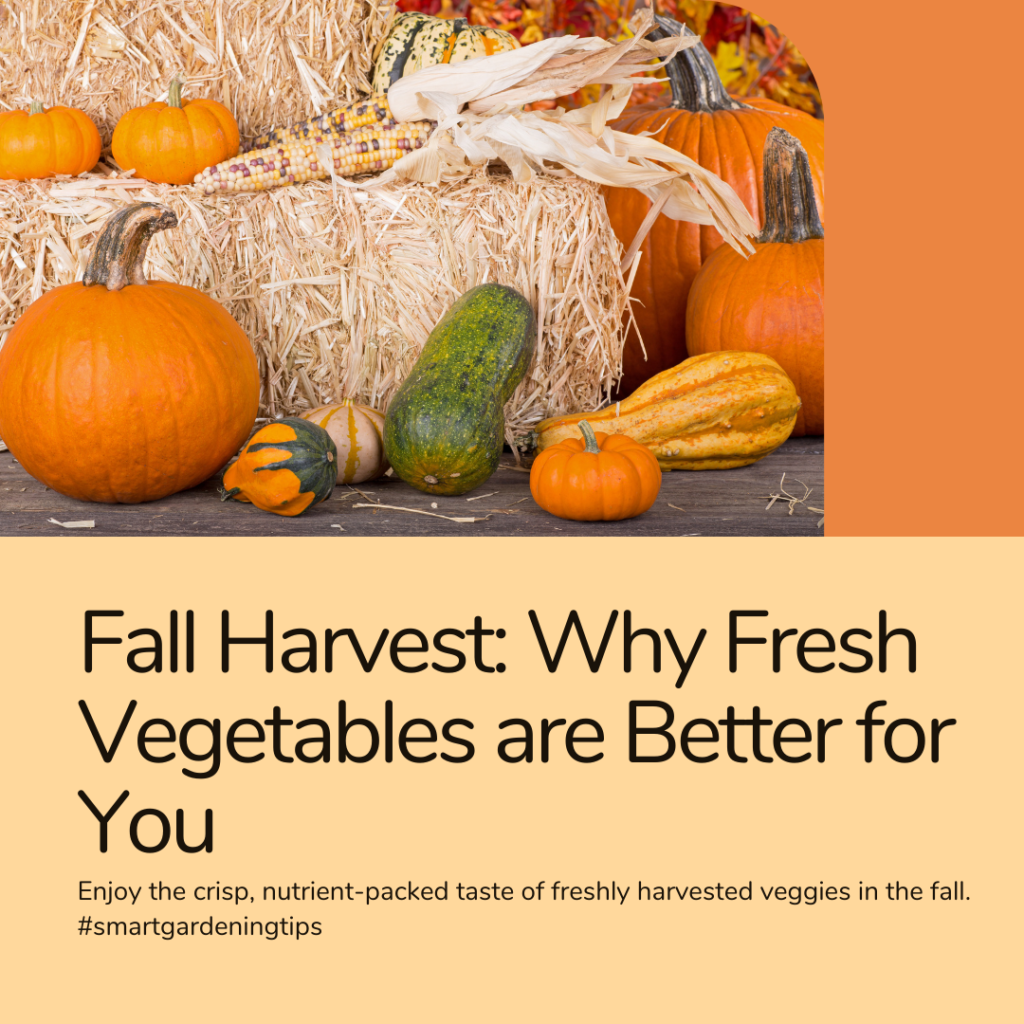
When it comes to enjoying the freshest and most flavorful vegetables, there’s no better time than the fall season. Harvesting fresh vegetables from your own garden during this time of year brings a host of benefits that both your health and taste buds will appreciate.
First and foremost, fall vegetables are packed with essential vitamins, minerals, and antioxidants that contribute to a healthy diet. These nutrient-rich vegetables, such as kale, broccoli, and Brussels sprouts, provide a range of health benefits, including boosting your immune system and reducing the risk of chronic diseases.
In addition to their nutritional value, fall vegetables offer a diverse and vibrant array of flavors to elevate your culinary experiences. From the earthy sweetness of roasted butternut squash to the crisp and peppery taste of radishes, these vegetables add depth and complexity to any dish.
Another significant advantage of harvesting fresh vegetables in the fall is the reduction in pests and diseases that commonly affect crops during the warmer months. Cooler temperatures naturally deter many pests, reducing the need for chemical interventions and making organic gardening more attainable.
“Autumn is a second spring when every leaf is a flower.” – Albert Camus
Furthermore, fall gardening can be a gratifying and fulfilling activity. The process of sowing seeds, caring for your plants, and finally reaping the rewards of a bountiful harvest can provide a sense of accomplishment and joy. It connects you to nature and allows you to appreciate the cycles of the seasons.
With fall vegetables easily stored, you can extend the enjoyment of your harvest well into the winter months. Canning, freezing, and pickling are just a few preservation methods that will ensure you have access to the flavors of autumn throughout the year.
Whether you’re a seasoned gardener or a novice, harvesting fresh vegetables in the fall is a rewarding experience that offers both health benefits and culinary delights. So roll up your sleeves, get your hands dirty, and embrace the season by cultivating your own homegrown produce.
| Benefits of Harvesting Fresh Vegetables in the Fall |
|---|
| Fresh Source of Nutrients |
| Enhances Culinary Experiences |
| Natural Pest Deterrents |
| Connects You to Nature |
| Allows for Year-round Enjoyment |
FAQ
Q. What are the best crops to harvest in autumn?
A. Some of the best crops to harvest in autumn include leafy greens like kale and spinach, root vegetables like carrots and beets, and cold-hardy fruits like apples and pears.
Q. What are some autumn crop suggestions for home gardeners?
A. Home gardeners can consider planting crops such as Brussels sprouts, winter squash, radishes, and herbs like parsley and thyme for a bountiful autumn harvest.
Q. What are some tips for growing crops successfully in the fall season?
A. To grow crops successfully in the fall season, it’s important to choose cold-tolerant varieties, start seeds early, provide adequate sun exposure, maintain soil moisture, and use frost protection measures when necessary.
Q. What are some nutritious fall vegetables to grow?
A. Nutritious fall vegetables to grow include broccoli, cauliflower, Brussels sprouts, and kale. These vegetables are packed with vitamins, minerals, and antioxidants that promote good health.
Q. What are some autumn fruits for a bountiful harvest?
A. Some autumn fruits for a bountiful harvest include apples, pears, grapes, and berries. These fruits thrive in cooler temperatures and can be enjoyed fresh or used in various recipes.
Q. What are some herbs and spices for fall harvest?
A. Herbs and spices for fall harvest include sage, rosemary, thyme, and cinnamon. These aromatic plants can add delightful flavors to your dishes and can be preserved for later use.
Q. What are some creative ways to use herbs and spices from your harvest?
A. You can use herbs and spices from your harvest to infuse oils, make homemade seasoning blends, create herb-infused butters, or add them directly to your favorite recipes for an extra burst of flavor.
Q. How can I preserve my autumn harvest?
A. You can preserve your autumn harvest by canning, freezing, drying, or pickling your fresh produce. These methods help extend the shelf life of your crops and allow you to enjoy them throughout the year.
Q. What are some tips for extending the shelf life of your autumn harvest?
A. To extend the shelf life of your autumn harvest, store your produce in cool and dark places, avoid washing fruits and vegetables until ready to use, remove any spoiled or damaged items, and consider using proper storage containers.
Q. What are the benefits of harvesting fresh vegetables in the fall?
A. Harvesting fresh vegetables in the fall allows you to enjoy the peak flavors and nutritional value of homegrown produce. It also provides a sense of satisfaction and connection to the seasonal rhythms of nature.
Conclusion
In conclusion, by following our autumn crop harvest suggestions, you can enjoy a bountiful and nutritious harvest from your garden. With a wide variety of crops to choose from, you have the opportunity to select the best vegetables, fruits, herbs, and spices that thrive in the cooler temperatures of the fall season.
By implementing our expert tips for successful autumn crop growth, you can maximize your yield and ensure that your plants are healthy and robust. From soil preparation and watering techniques to pest control methods, taking the necessary precautions will contribute to a successful harvest.
And don’t forget about the numerous benefits of harvesting fresh vegetables in the fall. Not only will you have access to nutrient-rich produce that enhances your health, but you will also have the opportunity to savor the unique flavors of autumn in your home-cooked meals.
Lastly, with our guidance on preserving your autumn harvest, you can enjoy your homegrown produce even after the season is over. By utilizing various storage techniques such as canning, freezing, drying, and pickling, you can extend the shelf life of your crops and savor the taste of fall throughout the year.
















